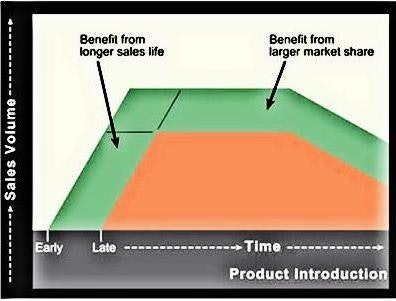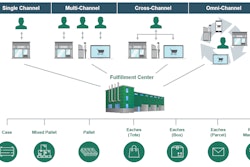
Editors Note: The following article is brought to you by IHS Markit in partnership with the Supply Chain Network.
Engineering organizations are under relentless pressure to speed lifecycle times, while also reducing development costs. Given the tremendous effort and resources that a new product launch requires, product launch delays can cost an organization a significant percentage of its return on investment.
Companies in engineered-product industries face especially complex and costly product-development challenges. Chief among these challenges is the need to reduce time to market and get products launched ahead of competitors. In return, companies gain from:
- Increased Sales and Better Profit Margins. The earlier the product reaches the market, relative to the competition, the longer the lifespan of that product.
- Lower Development Costs. Streamlined processes, limited iterations, and reduced slack free up financial and operating resources for other value-adding activities.
- Larger Market Share. An early-to-market product is less likely to face initial competition. A quick introduction also allows more time for companies to build market share before their products become commodities.
- Greater Market Responsiveness. Companies that bring products to market faster can react more quickly to competitors’ moves or market shifts with their own product innovations, while also besting competition by gaining first-mover advantage.
Selling at Peak
Surprisingly, research hasn’t really attempted to estimate the economic consequences of postponed product launches, according to Vinod Singhal, departmental editor for Production and Operations Management at Georgia Institute of Technology, and Kevin Hendricks, operations management professor at Wilfrid Laurier University. In “The Effect of Product Introduction Delays on Operating Performance,” they analyzed the financial performance of over 450 publicly traded companies, across industries, that experienced product launch delays over a 16-year period.
“We find that product introduction delays have a statistically significant negative effect on profitability,” says Singhal. “The effect of the delay is negative regardless of when it occurred in the product development process or the time of year of the announcement.”
And yet, the average new product development project exceeds its schedule by 120 percent, according to the Center for New Product Development. Reasons for delayed product launches include:
- Poor management of the development process
- Frequent design changes
- Lack of coordination among different functional areas
- Resource shortages
The impact of launch delays depends upon industry-specific levels of competition. In competitive markets, for example, the end point is fixed by others. As a result, any delay directly reduces your time in market, effectively narrowing the window of time a product sells at peak. The upfront sunk costs (ideation, development, marketing, and launch), along with the cost of capital, decrease the net present value represented by the product over time.
Impact on Revenues and Profitability
Product introduction delays can negatively impact revenues—from reducing the window of opportunity to generate revenues to causing the product to become obsolete faster, note Singhal and Hendricks. In fact, over the lifecycle of a particular product, everything from higher development expenditures to postponed revenue realization to revenue penalties can all dramatically impact profitability.
“In a competitive industry, customers may not be willing to wait, choosing to buy a competitor’s product instead,” Singhal says. If your product launch is delayed by six months, that’s six months for your competitor to grab market share and woo your customers, and less overall revenue for you to pursue when you finally do go to market. For example, in the electronics industry, a late product introduction (9-12 months beyond target) can cost 50 percent of a product’s anticipated revenues.
Impact on Shareholder Value
Shareholders care about time-to-market. In fact, product delay announcements decreased average shareholder value by about 12 percent, according to Singhal and Hendricks. “Our results suggest that negative stock market reaction to product introduction delays is actually quite rational given the impact of delays on profitability.”
Management consulting firm OakStone Partners estimates that a product delay can cost a company upwards of 15 to 35 percent of the Net Present Value (i.e., the difference between the present value of the future cash flows from an investment and the amount of investment or “NPV”), depending on whether it involves a monopolistic product or a competitive product (competing with other companies to deliver similar products or serve the same markets).
When customer interests wane and market share is lost, revenue penalties prevail.
Measuring Product Launch Time Impact: Net Cash Flow vs. Product Revenue
Overall product revenue might be a good measure for the financial health of a company, but net cash flow provides a better indicator of the value a product provides to the company. Net cash flow not only factors in the revenue generated by selling the product, but also the sunk costs of developing and manufacturing the product.
 Figure 1
Figure 1
Figure 1 (above) shows these values over time for a typical product lifecycle. Early in the product’s life, it costs organizations money to conceive, develop, market and launch the product; revenues then follow. At some point, market saturation occurs, sales plateau and then begin to decline, and eventually the product is taken off the market. From this point, there are more sunk costs for the company associated with ‘end-of-lifing’ the product—ongoing support costs, disposing of components that are no longer needed, raw materials, surplus machinery, and removing the product from the company’s business systems.
Once a product is launched and reaches maturation, revenue plateaus and drops off. The product launch point signifies the point at which a company starts to make money on the product. Should the launch date be delayed, the upfront development, marketing, and launch costs continue, thus negatively impacting cash flow and reducing the amount of money the company makes off a product over time.
The question is, can your organization lead the market losing 15 percent to 35 percent or more of NPV? Or, can you lead the market realizing only 65 percent to 85 percent of your product’s value? And, how will the delay impact company growth?
What would it mean to your organization to accelerate time to market by a week? Or a month, or more? What will be the impact on the maximum sales if your product is three months late to market? How about six months? Will late entry adversely affect market share? These are all important questions to ask yourself as you formulate a solid go-to-market strategy.
Maximizing Market Potential
The key to maximizing market potential lies in launching your products on time and within the expected quality and cost. To minimize delays, you’ll need to:
- Understand customer requirements. Experts estimate as much as 25 percent to 45 percent of all costs in engineered products add no value for the product or customer. It’s critical to ensure new products uniquely or more cost-effectively address unmet needs in current markets and/or in new or adjacent markets.
- Understand the competitive landscape. Patents, websites, journal articles, product and company literature, social media, blogs, and forums all serve as critical information sources. But rushed for time and overwhelmed by too much data, product designers are often forced to proceed without a comprehensive understanding of the competitive landscape. Emerging competitors, blocking IPs, or advances in new technologies are easily overlooked. Most organizations performing competitive intelligence today are crying out for better integration of information from the vast sea of content available to them. Arm engineers with tools to keep them ahead of the competition; build product roadmaps and strategies with insight into competitive activities, technology breakthroughs, patent awards, market shifts, and more.
- Reduce the number of product changes. Identifying and addressing potential gaps early in the design phase exponentially improves product launch timelines. Initial designs are influenced by optimal performance and not usually for manufacturing efficiency and cost. As design requirements evolve throughout the product development process, this can throw a wrench into the project timeline. For this reason, it’s important to work with a manufacturer that’s experienced with similar products and has been exposed to what works (and what doesn’t). Another crucial consideration is working with a factory that has existing equipment and know-how with a specific category of products.
- Enable knowledge reuse to make better decisions, faster. Product development is experience-driven. Companies should maximize reuse of the solutions they develop and the lessons they learn. All too often, this knowledge and expertise is buried in enterprise systems or siloed in parts of the business and undiscoverable by engineers. Experts estimate that rework accounts for up to 40 percent of total project costs. Efforts to centralize data in content management systems fail and traditional enterprise search is insufficient for engineers, scientists or researchers who want answers to their questions—not a list of links to mostly irrelevant documents.
Engineering requires technical proficiency and precise communication, combined with the ability for global product development teams to communicate, collaborate, and connect with colleagues, experts, information, and insights on-demand and regardless of language or location. When these elements align and support the new product development process, companies can improve their time-to-market and compete more effectively within their own industries.












